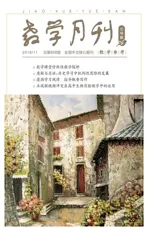遵循学习规律 指导概要写作
2018-12-05陈娇玲
□陈娇玲
(浙江省宁波中学,浙江宁波 315100)
一、引言
概要写作是浙江省英语新高考的全新写作题型,它的诞生给教师和学生带来十足的压力。概要写作时考生要在正确理解文章的基础上,在不改变原文中心思想、体裁和结构的前提下,用简明、精练的语句高度浓缩文章的主要内容和观点。
A summary is a short statement that gives only the main points of something,not the details.It is a brief,complete and objective restatement of the main idea and key points of a longer composition[1].基于上述定义,概要写作需要符合以下要求:No details/examples/repetition/comments/copying,即省略细节,删除例子,避免重复,不做评论,不抄袭原文。此外,概要写作的评分标准可以概括成4C原则,即:
1.Complete——理解准确,涵盖全部要点;
2.Correct——能准确使用相应的语法结构和词汇;
3.Coherent——有效使用语句间的连接成分,使所完成的概要结构紧凑;
4.Concise——简洁地使用自己的语言。
Jim Scrivener认为,学生的学习经历“无知(Ignorance)—暴露(Exposure)—注意(Noticing)—理解(Understanding)—运用(Active use)—实践(Practice)”这样一个逐步递进的过程[2]。
因此,在概要写作教学中,教师可以遵循这个学习规律,设计科学的教学步骤,循序渐进,步步为营,使学生从一开始的茫然,到逐步接受,直至最后的产出。
二、教学实践与探索
下面以浙江省名校新高考研究联盟2018届第三次联考的概要写作题为例(阅读材料详见教学月刊网站www.jxyk.com“资料下载”中的“原文选登”),探讨如何让学生对概要写作从无知到接受,进而准确、到位地解读文本,最终生成一份完美的概要。
Step 1.暴露+初次注意(Exposure+First noticing)
1.读文本,读体裁——Read for the style of the passage.
【点拨】记叙文的主要特征是描述一个事件,即to tell a story,并以故事的几个基本要素who,when,where,what,why,how等为主要特征。议论文就某个主题或议题展开争执或讨论,大家提出各种不同的观点,目的是为了说服别人,即to argue over something and to persuade。说明文是对客观事物做出说明或对抽象事理进行阐释,使人们对事物的性质、成因、关系等能有科学的认识,即to explain。
【解析】各类体裁的文章在形式、结构、语言运用上各有特点。了解文章的体裁分类、各类体裁的基本特点,才能准确把握阅读文本的体裁,为有针对性地解读文本打下基础。快速浏览后发现,例文是比较典型的说明文,说明了电子设备对青少年视力的影响这个现象。
2.读主题,读结构——Read for the topic and structure of the passage.
【点拨】说明文的主题从主题段中找,其一般落脚于第一段,开门见山,直抛主题。说明文的典型结构有“The author talks about…It’s caused by … As a result/Consequently...”或“The author states/presents the phenomenon of…Because…(原因1)and…(原因2).Therefore...
【解析】文本结构是作者为表现主旨而对写作材料进行精心构思安排的结果,是文章部分与部分、部分与整体之间的内在联系和外部形式的统一,是行文思路的具体表现[3]。通过建构文本结构,学生不仅能快速和更好地理解文章的主要内容,而且还能学会如何设置主题句以及如何建立段落之间的联系和层次。例文的篇章结构是:介绍某现象—分析原因—提出建议。第一、二段导入话题,提出现代电子设备对孩子健康,尤其是视力的影响;第三、四段通过眼科专家的视野,分析出现此现象的原因及严重性;第五段给出可行性建议。
Step 2.有意注意和初步理解(Noticing+First understanding)
1.找各段关键句或关键词——Find the topic sentences or key words of each part.
【点拨】主题句的位置通常有以下几种。
(1)主题句通常置于段落开头,开门见山地提出问题,随之辅以细说。其作用是便于读者迅速把握主题,抓住段落的中心思想。此为演绎法。
(2)主题句也常置于段落末尾,可以给读者设置一种悬念,同时给读者的印象也特别深刻。放在段末的主题句,通常还有对前面所述内容做总结的作用。这可称为归纳法。
(3)有时主题句会出现在段落中间,有时主题句也含而不露,隐藏在全段的字里行间。
【解析】在确定了体裁的基础上,引导学生通过关注和寻找主题句,厘清文本脉络,是概要写作的关键一步。只有在踩点正确的前提下,才能抓住文本主线,掌握文本主要内容,为概要的后续步骤做好铺垫。例文的主题句(关键句)或关键词为:
Para 1.Children spend so much time staring at screens.
Para 2.Their health might be at risk;Eyesight is worsening.
Para 3.Lack of natural light seems to be the key issue;Studying a lot online.
Para 4.A dilemma:academic success or eyesight protection.
Para 5.It’s time to hit the“off”button and get our children outside.
2.省去细节和实例——Leave out details and reduce the examples.
【点拨】细节主要体现在同位语、描述性形容词、举例、数据、人物、地名等对文本意义不大的细枝末节等,这些内容对文章主干没产生多大影响,都可以省略。如:
Para 1.These days there is so much tempting technology to look at:smartphones,tablets,computer games and TV screens.(删去举例)
Para 3.Chris Hammond,consultant ophthalmic surgeon at St Thomas’Hospital,(省略同位语)said,“We know that short-sightedness is becoming more common.It has spread greatly in EastAsia,Singapore,Taiwan,South Korea,(删去举例)where approaching 90%of 18-yearolds are now short-sighted.”Annegret,expert at Moorfields Eye Hospital in London(省略同位语)says lack of natural light seems to be the key issue.She’s suggested that children in East Asia(省略地名)study a lot online,using computers,smartphones or tablets,(删去举例)and they go outside less,which could be a cause of short-sightedness.本段中提到两位专家的具体细节,直接用some experts来代替。
【解析】一篇文章的信息量和细节往往较多,学生很容易被大量的信息所困住,无法提炼出中心思想和关键要点。通过上述技巧的运用,学生就能快速抓住文章的主干和框架,对接下来的信息重建至关重要。
Step 3.深层理解+主动运用(Second un⁃derstanding+Active use)
1.列要点,重建构——Use your own words.
【点拨】在思维替换中,我们经常用到:同义替换法、词性转换法、改变语态法、句式转换法、压缩长句法等,其实质就是替代、合并和改写句子。如:
Para 1.These days there is so much tempting technology to look at.可以进行以下改变:
(1)词性转换法、改变语态:Children are tempted by/attracted to so many electronic devices.
(2)同义替换法:Children are glued to/are attached to/get hooked on so many electronic screens.
(3)同义替换法:Children can hardly tear themselvesawayfrom somanyelectronic screens.
Para 2.There is a concern that their health might be at risk.And there is a fear that their eyesight is worsening.可以进行以下改变:
(1)同义替换法:It will put their health and eyesight at risk(stake)/in danger.
(2)同义替换法:It will endanger/harm/do harm to/be harmful to their health and eyesight.
Para 3.Annegret says lack of natural light seems to be the key issue.She’s suggested that children study a lot online and they go outside less,which could be a cause of short-sightedness.可以进行以下改变:
同义替换法:Lack of natural light and studying a lot cause/lead to/contribute to/result in children’s short-sightedness.
Para 4.This leads to a dilemma:achieving short-term academic success or protecting your long-term eyesight.可以进行以下改变:
(1)同义替换法:We may be torn/struggling/stuck/trapped between protecting eyesight and studying online.
(2)同义替换法、词性转换法、句式转换法 :It’s a tough choice between academic achievement and eyesight protection.
Para 5.We can’t turn a blind eye to this serious situation.可以进行以下改变:
(1)同义替换法:We can’t(afford to)ignore/neglect/take no notice of/pay no attention to this serious situation.
(2)改变语态法:This serious situation can’t be ignored/neglected/taken no notice of/paid no attention to.
【解析】用自己的语言重建文本主要信息是个很大的工程,很多学生不知从何下手。通过上述技巧的点拨,学生明白了如何从小处着手,如何将语言巧妙重组,如何真正展示自己的语言基本功,实现了如何让概要写作处处生辉。
2.巧衔接,连段落——Add transitional expressions to make your summary coherent.
【点拨】过渡词是语言连贯性得以实现的重要手段。例文分析原因的三、四两段中,第三段指出导致近视的原因是因为学生为了学习而长时间使用电子产品和很少外出活动,第四段提出了要成绩还是要视力的难题,两段之间有明显的转折关系,因此,我们用however来衔接。
【解析】巧用衔接词,把握句与句之间的逻辑转承关系,能增加文章的顺畅、和谐和美感,同时也能提高学生的谋篇布局能力。
Step 4.主动运用+经常实践(Active use+Practice)
1.主动运用,完美呈现——Active use
【点拨】将以上步骤中的技巧综合运用,生成文稿。如:
Nowadays,children are glued to various electronic screens,which has raised people’s concern about their health,especially their eyesight.(要点 1)Some experts think doing heavy school work through a screen and lack of natural light can cause children’s short-sightedness.(要点2)However,that leads to a dilemma between protecting eyesight and studying online.(要点3).Obviously,the increasing number of short-sighted children at early age warns us not to ignore the problem.(要点4)
【解析】主动运用是学生的语言产出阶段,是综合能力的体现。基于前面循序渐进的铺垫,学生已渐入佳境,形成自己的学习策略和思想,对文本的理解和表达呼之欲出,学习主体的能动性得以最大程度的激发。
2.总结经验,多加实践——Practice
【点拨】概要是主旨及关键信息的总结和提炼,词数要求在60~80之间,所以在成文时要除例子、省细节、删重复等。根据评分标准的4C原则,还要使概要要点齐全、语言准确、结构紧凑、语言简练。
【解析】终稿要尽善尽美,在各处细节上都要润色、完善。核对概要的评分标准,让终稿精、简、顺、达。当然,熟能生巧,要使自己在概要写作上得心应手,还需多进行专题训练。
三、结语
从上述实例来看,概要写作教学完全遵循了学习规律,让学生在概要写作中经历“无知(Ignorance)—暴露(Exposure)—注意(Noticing)—理解(Understanding)—运用(Active use)—实践(Practice)”这样一个逐步递进的过程,使学生在掌握主旨大意、列出各段关键信息、将内容分项扼要表述、用自己的语言组织内容、巧用衔接词、修改、定稿、课外实践的过程中循序渐进,步步为营,最终达到掌握概要写作技能的目的。

